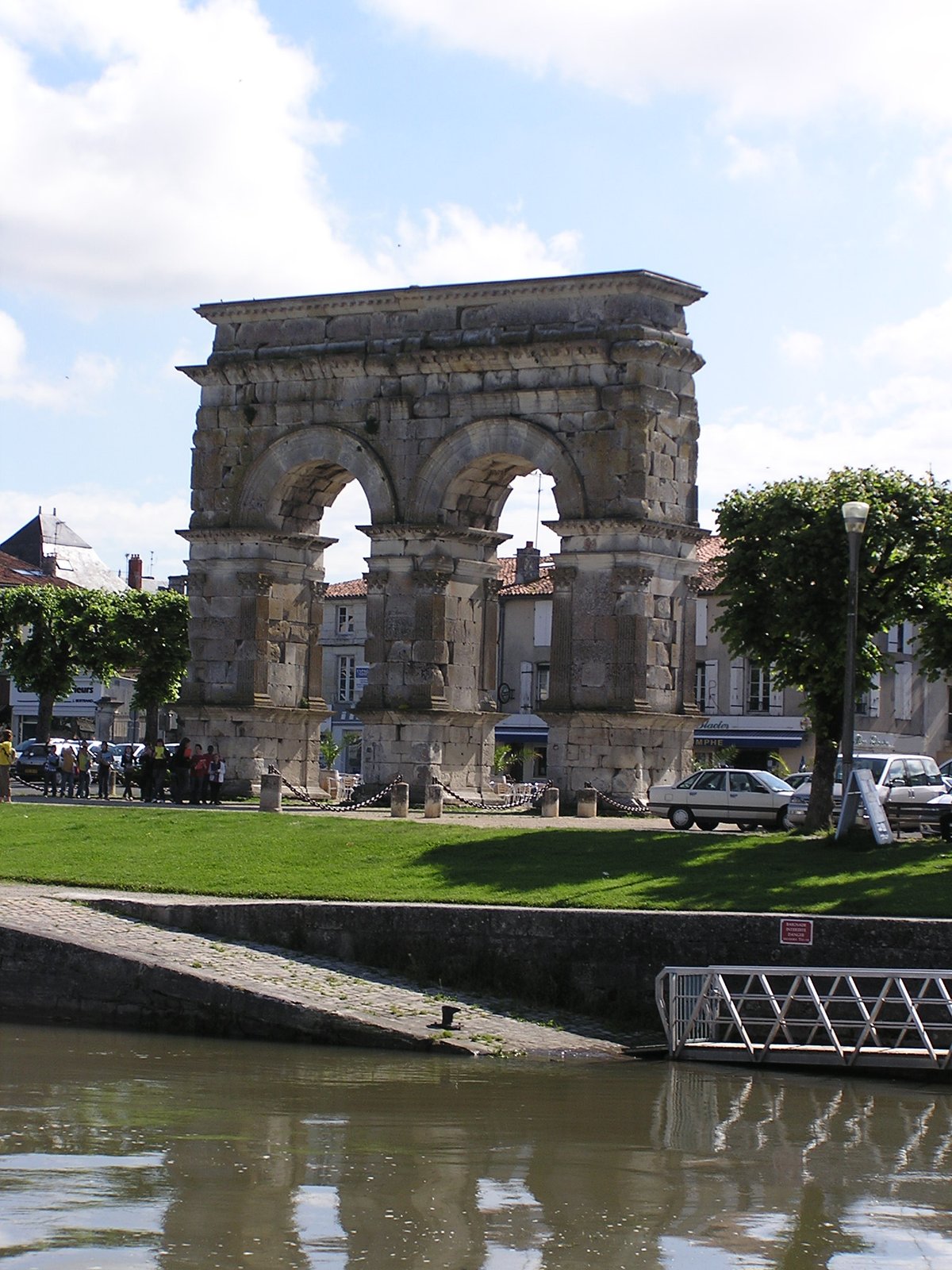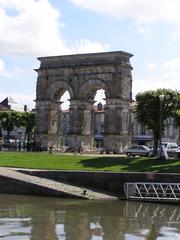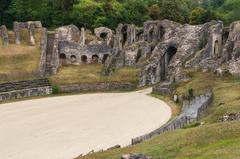
Visiting Arc de Germanicus in Saintes, France
Published Date: 19/07/2024
Introduction to Arc de Germanicus
The Arc de Germanicus, located in Saintes, France, is a monumental example of Roman engineering and architecture. Constructed between 18-19 AD by Emperor Tiberius, it was dedicated to his adopted sons, Germanicus and Drusus Caesar, serving initially as the grand entrance to the city of Mediolanum Santonum, now known as Saintes (Arc de Germanicus). This triumphal arch is adorned with intricate limestone carvings and Latin inscriptions that commemorate military achievements. Its relocation in the 19th century to Place Bassompierre, led by Prosper Mérimée, underscores the significance of historical preservation (Arc de Germanicus). Today, the Arc de Germanicus stands as a symbol of Saintes’ rich Roman heritage, attracting thousands of visitors annually.
Table of Contents
- Introduction
- History of Arc de Germanicus
- Visitor Information
- Nearby Attractions and Accessibility
- Unique Aspects
- Cultural and Educational Impact
- FAQ Section
- Conclusion
History of Arc de Germanicus
Construction and Roman Influence
Constructed between 18-19 AD by Emperor Tiberius, the Arc de Germanicus honored his adopted son, Germanicus, and his nephew, Drusus Caesar. Originally part of the Roman bridge over the Charente River, it marked the entrance to the city of Mediolanum Santonum, now Saintes, highlighting its significance as a Roman settlement and hub of commerce and military activity (Arc de Germanicus).
Architectural Design and Features
This triumphal arch is a classic example of Roman architecture, featuring grandiose and symmetrical design. Made of limestone, it consists of two large arches flanked by smaller side arches. The arch is adorned with intricate carvings and Latin inscriptions celebrating the achievements of Germanicus and Drusus Caesar (Arc de Germanicus).
Relocation and Preservation
In the 19th century, the Arc de Germanicus was threatened by the construction of a new bridge. Prosper Mérimée led efforts to save it, resulting in its dismantling and relocation to Place Bassompierre in 1843. The relocation involved meticulous planning to ensure accurate reconstruction, highlighting the growing awareness of historical preservation (Arc de Germanicus).
Historical Significance
The Arc de Germanicus is one of the few remaining Roman triumphal arches in France, symbolizing the Romanization of Gaul. It offers insights into Roman political and military history, with inscriptions celebrating the military campaigns of Germanicus and Drusus Caesar (Arc de Germanicus).
Archaeological Discoveries
Excavations around the arc have unearthed artifacts like pottery, coins, and tools, shedding light on Roman life in Saintes. Notable discoveries include Roman inscriptions and reliefs, now displayed in the nearby Musée Archéologique de Saintes.
Restoration and Conservation Efforts
Recent restoration projects have focused on cleaning and stabilizing the limestone, repairing carvings, and protecting the arc from environmental factors. These efforts ensure the arc remains a well-preserved landmark for future generations (Arc de Germanicus).
Visitor Information
Ticket Prices
Visiting the Arc de Germanicus is free of charge, making it an accessible attraction for all.
Visiting Hours
The arc can be visited at any time, but the best hours are during daylight to fully appreciate its details.
Best Time to Visit
Spring and autumn are ideal for visiting due to mild weather and fewer crowds.
Tips for Visitors
- Wear comfortable shoes for walking around Saintes.
- Bring a camera for stunning photos of the arc.
- Check out guided tours for a more informative experience.
Nearby Attractions and Accessibility
Other Historical Sites in Saintes
- The Saintes Amphitheatre
- The Abbaye aux Dames
- The Saint-Eutrope Basilica
Accessibility Information
The arc is easily accessible from the city center. Parking is available nearby, and the site is wheelchair accessible.
Unique Aspects
Special Events
Occasional events and reenactments are held at the arc, offering a glimpse into Roman history.
Guided Tours
Guided tours provide detailed historical insights and are highly recommended.
Photographic Spots
The arc itself and the surrounding Place Bassompierre offer excellent photographic opportunities.
Cultural and Educational Impact
Educational Programs
Educational workshops and programs are available, providing hands-on experiences in archaeology and history.
Cultural Significance
The Arc de Germanicus is a cultural landmark, attracting thousands of visitors annually and fostering appreciation for Roman heritage.
FAQ Section
Q: Are there any fees to visit the Arc de Germanicus?
A: No, visiting the arc is free of charge.
Q: What are the best times to visit?
A: Spring and autumn for mild weather and fewer crowds.
Q: Is the site accessible for people with disabilities?
A: Yes, the site is wheelchair accessible.
Conclusion
The Arc de Germanicus stands as a remarkable example of Roman architecture and a symbol of the Roman legacy in Gaul. Its history and preservation reflect the importance of cultural heritage. Plan your visit today to experience this historical marvel firsthand. For more information, visit the Saintes Tourism website.
References
- Arc de Germanicus - Visiting Hours, Tickets, and Historical Insights in Saintes, 2024, Saintes Tourism
- Exploring the Arc de Germanicus - Visiting Hours, Tickets, and Historical Significance in Saintes, 2024, Saintes Tourism
- Ultimate Guide to Visiting the Arc de Germanicus in Saintes - Hours, Tickets, and Tips, 2024, Saintes Tourism


